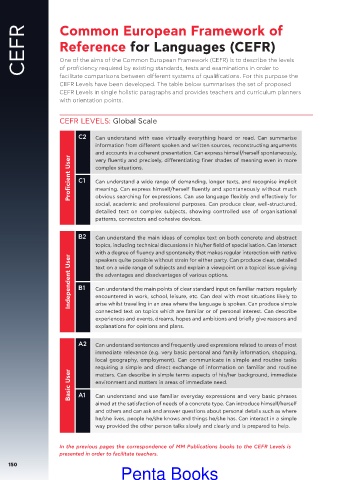Page 152 - Penta Book's Publisher Catalogue 1
P. 152
CEFR Common European Framework of
Reference for Languages (CEFR)
One of the aims of the Common European Framework (CEFR) is to describe the levels
of proficiency required by existing standards, tests and examinations in order to
facilitate comparisons between different systems of qualifications. For this purpose the
CEFR Levels have been developed. The table below summarises the set of proposed
CEFR Levels in single holistic paragraphs and provides teachers and curriculum planners
with orientation points.
CEFR LEVELS: Global Scale
C2 Can understand with ease virtually everything heard or read. Can summarise
information from different spoken and written sources, reconstructing arguments
and accounts in a coherent presentation. Can express himself/herself spontaneously,
Proficient User C1 complex situations.
very fluently and precisely, differentiating finer shades of meaning even in more
Can understand a wide range of demanding, longer texts, and recognise implicit
meaning. Can express himself/herself fluently and spontaneously without much
obvious searching for expressions. Can use language flexibly and effectively for
social, academic and professional purposes. Can produce clear, well-structured,
detailed text on complex subjects, showing controlled use of organisational
patterns, connectors and cohesive devices.
B2 Can understand the main ideas of complex text on both concrete and abstract
topics, including technical discussions in his/her field of specialisation. Can interact
with a degree of fluency and spontaneity that makes regular interaction with native
Independent User B1 text on a wide range of subjects and explain a viewpoint on a topical issue giving
speakers quite possible without strain for either party. Can produce clear, detailed
the advantages and disadvantages of various options.
Can understand the main points of clear standard input on familiar matters regularly
encountered in work, school, leisure, etc. Can deal with most situations likely to
arise whilst travelling in an area where the language is spoken. Can produce simple
connected text on topics which are familiar or of personal interest. Can describe
experiences and events, dreams, hopes and ambitions and briefly give reasons and
explanations for opinions and plans.
A2 Can understand sentences and frequently used expressions related to areas of most
immediate relevance (e.g. very basic personal and family information, shopping,
local geography, employment). Can communicate in simple and routine tasks
requiring a simple and direct exchange of information on familiar and routine
Basic User environment and matters in areas of immediate need.
matters. Can describe in simple terms aspects of his/her background, immediate
A1
Can understand and use familiar everyday expressions and very basic phrases
aimed at the satisfaction of needs of a concrete type. Can introduce himself/herself
and others and can ask and answer questions about personal details such as where
he/she lives, people he/she knows and things he/she has. Can interact in a simple
way provided the other person talks slowly and clearly and is prepared to help.
In the previous pages the correspondence of MM Publications books to the CEFR Levels is
presented in order to facilitate teachers.
150
Penta Books
4/1/2021 4:48:33 µµ
mm-Catalogue-2021_International_.indb 150 4/1/2021 4:48:33 µµ
mm-Catalogue-2021_International_.indb 150

